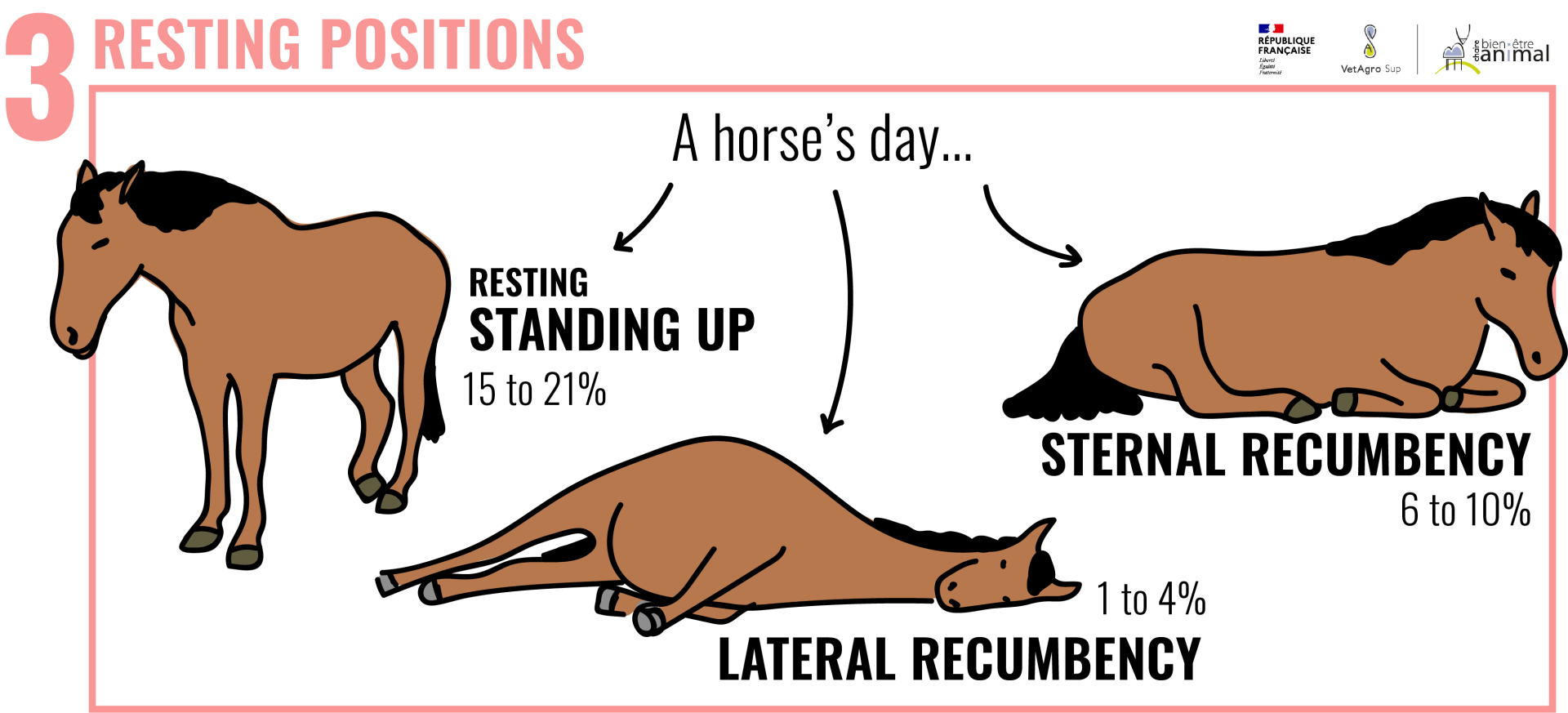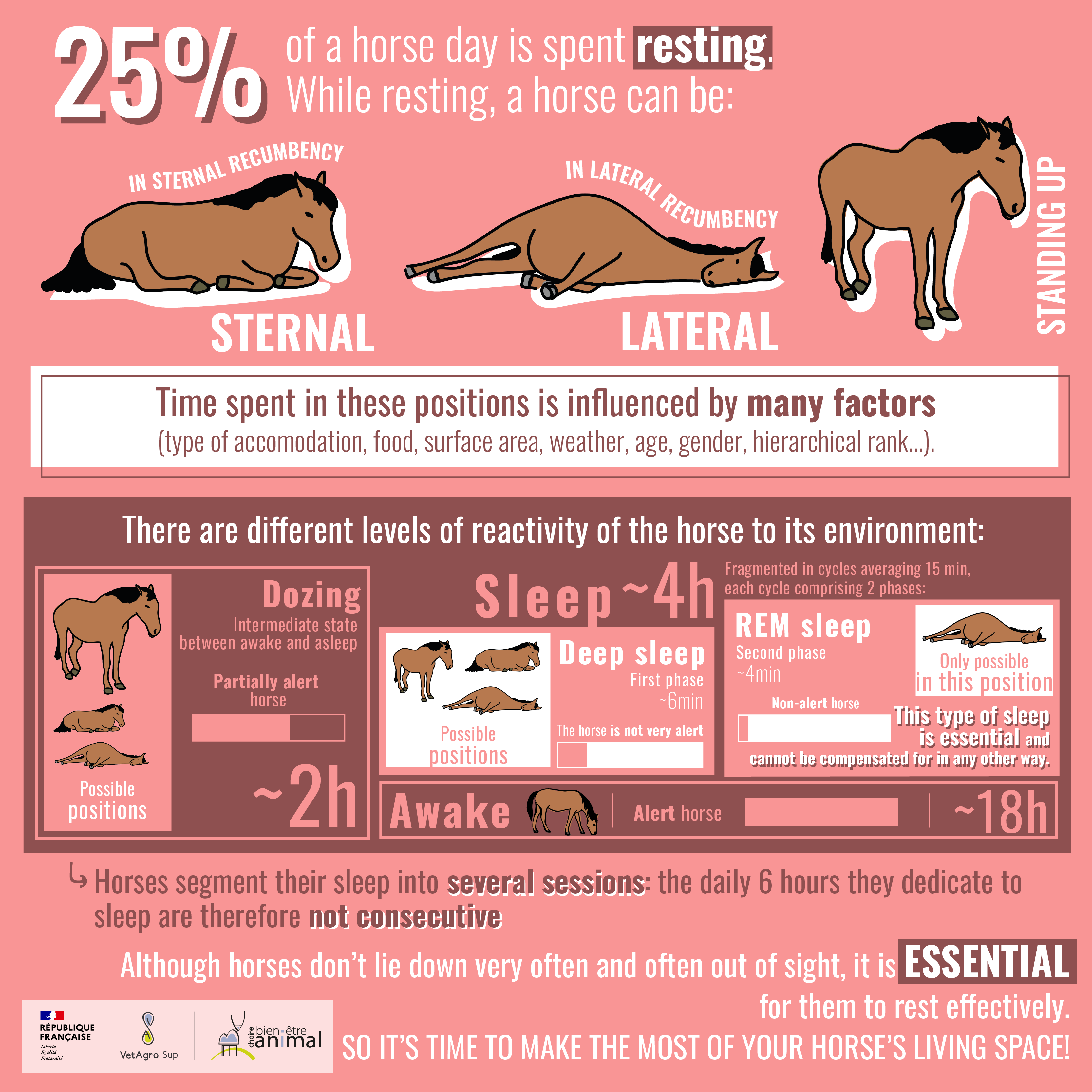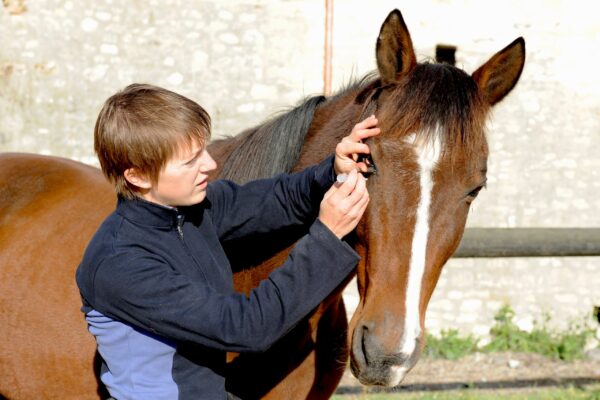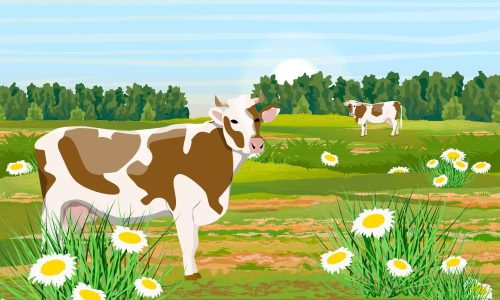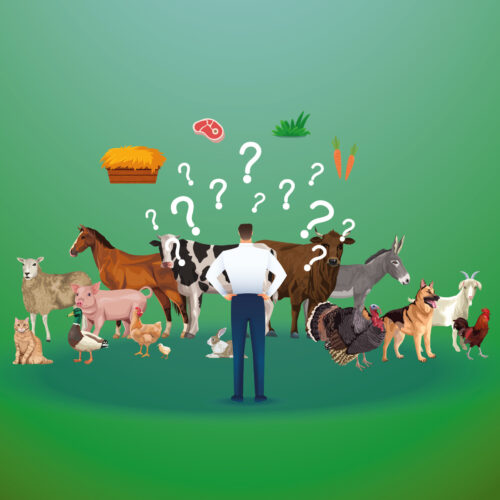

FALSE
Horses are unique in that they can partly rest standing up. On the other hand, REM sleep, which is essential to their health and welfare, can only occur if they are lying down completely!
Keep in mind
- A horse can rest upright or recumbent, in both sternal and lateral recumbency positions.
- Standing up, dozing predominates.
- Most sleep occurs during recumbency.
- Sleep is made up of cycles, which may or may not be consecutive. A sleep cycle begins with a phase of deep sleep. The second phase of the cycle, REM sleep, occurs only in lateral recumbency.
- The horse does not sleep for 4 consecutive hours: 5 to 7 sessions are spread over 24 hours, preferably at night.
As we saw in a previous “Popular belief article”, in natural conditions, resting is the horse’s second most important activity over the course of a day. A horse spends 25% of its time lying down, i.e. a total of around 6 hours every 24 hours[1][2][3][4].
While resting, horses are either[5][6] :
- Standing (15-21% of their time budget). There are several clues to differentiate a standing horse that is resting from a standing horse that is observing: eyes half-closed, neck close to horizontal, muscles relaxed – the lower lip droops relaxed –, and ears pointing to the side or back (but not flat). Another important sign of standing rest is that one of the hind legs may be cocked. The hoof then only touches the ground via its tip.
- Sternal recumbency (6 to 10% of the time budget): the horse lies on its belly and sternum, with its limbs tucked underneath. The neck and head show the same characteristics as when resting upright. Sometimes the head touches the ground. The horse is also said to be lying “cow-like”.
-
Lateral recumbency (1 to 4% of the time budget): the horse lies flat on its side. There is no muscle tone left.
The time spent in each of these positions is influenced by a number of factors[8][9] : type of accommodation (which may favor “forced” rest in the event of boredom, for example), feed, type of ground, available surface area, weather, age (foals rest more than adults), sex, hierarchical rank and degree of familiarity with the environment. For example, a stressed horse will prefer standing to lying down.

Did you know?
Horses can rest on three limbs, virtually effortlessly, thanks to an anatomical feature known as the stay apparatus. This is a set of muscles, ligaments and tendons that enable the horse to "lock" the kneecap of its hind limb, thus preventing flexion of the leg joints (stifle and hock)[7] opposite the one which is flexed. The horse rests its left and right hind legs alternatively.
In total – whether in sternal or lateral recumbency – studies estimate that the time horses spend lying down is between 30 min and 2 hours every 24 hours. However, horses never lie still for very long, on average around twenty consecutive minutes[6], for two reasons. The first relates to the horse’s status as prey: it takes longer to flee from danger while lying on the ground than when standing upright, ready to flee. In groups of horses in natural conditions, horses take turns to watch over group members resting on the ground[9][10]. The second reason is linked to the horse’s large mass, which, in a prolonged recumbent position, induces compression of internal organs and can thus generate circulatory, respiratory and other disorders [6][9]
In spite of this, we’ve just seen that, except in cases of illness, disease or an overly stressful environment[11], horses still lie down at least once during the day. This is because these three positions do not provide the same level of rest.
Rest in all its forms
Dozing
Dozing is an intermediate state between awake and asleep. It occurs mainly when the horse is resting upright, but also when lying down, in sternal and lateral recumbency, before falling asleep. The horse remains partially alert to what is going on around it: somnolence can therefore be interspersed with phases of wakefulness. This state accounts for a third of a horse’s daily resting time (6 hours), i.e. around 2 hours. Dozing alone is not enough to guarantee effective rest.
Sleep
Sleep refers to a lower level of sensitivity to the environment. The horse is said to be asleep. Sleep occurs in cycles, lasting 15 minutes on average, with each cycle comprising two phases:
- The deep or slow-wave sleep phase occurs first. It can occur in the upright or lying position (sternal and lateral recumbency). The average duration of this phase is estimated at 6 min. This is the only form of sleep that can occur when the horse is upright, as slight muscle tone is possible during this phase. At this stage, the horse is 10 times less reactive to its environment than in the dozing phase. A deep sleep phase precedes each REM sleep phase.
- The second phase is REM sleep. This is the phase when the horse is least reactive to its environment. Its average duration is estimated at 4 min. Learning is consolidated during REM sleep. This is only possible when the horse is lying on its side!

Did you know?
REM sleep is so called because it is characterized by a total absence of muscle tone and, at the same time, intense brain activity comparable to that of the waking phase! In particular, involuntary movements of the eyes, limbs, ears and facial muscles can be observed, earning it the name "REM (Rapid Eye Movement) sleep". It is during this phase of sleep that human dreams occur.
In total, REM sleep accounts for less than an hour daily[12] Yet its expression is essential for the horse: it cannot be compensated for by other forms of rest – even deep or slow-wave sleep. Thus, if a horse is unable to lie down for a given period of time, an over-expression of REM sleep in the lateral recumbent position will be observed following this period of deprivation[8]. This phenomenon, which applies to many behaviors, is known as the “rebound effect”.
Sleep cycle distribution
Sleep occurs mainly at night, between 8pm and 5am, but also during the day, often between 12pm and 2pm[8]. The horse undergoes several sleep cycles (a phase of deep sleep followed by a phase of REM sleep), which may follow on directly from one another, or be separated by a phase of somnolence known as the “intermediate period”. Just like us? Not quite!
Unlike humans – and like all prey animals – horses segment their sleep into several sessions: their daily 6 hours of sleep are therefore not consecutive. Each sleep session, during which several cycles may follow one another, lasts an average of 30 to 40 min. There are around 5 to 7 sleep sessions in a 24-hour period[8], interspersed with wake-up phases when the horse gets up and devotes itself to other activities.
Conclusion
Many horse owners claim that their horse never lies down. If they don’t directly observe the horse lying down, certain clues can be useful: dirt on the body and especially in the tail hairs: bits of straw, leaves, stalks, etc. These clues can be very helpful.
As we’ve just seen, although horses don’t lie down much, and often out of sight, this is essential for them to sleep deeply (deep and REM sleep) and therefore rest effectively. It is therefore essential to create a living environment that is conducive to the expression of this behavior: a quiet place, a stable group, a dry, comfortable place and, above all, sufficient space. In the case of group housing, where horses may disturb one another, the surface area of an individual stall should not be taken as a reference, and it is recommended to double it to guarantee effective rest for all individuals[14].
At night, when they’re not sleeping, horses in natural conditions eat! Something to bear in mind when managing horses: while humans are advised against getting up at night to nibble, this is not true of horses, who should be able to nibble throughout the day and night.
In short
Thanks to Hélène Roche, ethologist and science popularizer, for her careful proofreading.
[1] Duncan, P., Time-Budgets of Camargue Horses Ii. Time-Budgets of Adult Horses and Weaned Sub-Adults. Behaviour 72, 26–48 (1980).
[2] Boyd, L. E., Time budgets of adult Przewalski horses: Effects of sex, reproductive status and enclosure. Appl. Anim. Behav. Sci. 21, 19–39 (1988).
[3]Boyd, L. E., Carbonaro, D. A. & Houpt, K. A., The 24-hour time budget of Przewalski horses. Appl. Anim. Behav. Sci. 21, 5–17 (1988).
[4]Kaseda, Y., Seasonal Changes in Time Spent Grazing and Resting of Misaki Horses. Jpn. J. Zootech. Sci., 464–469 (1983).
[5]Institut français du cheval et de l’équitation. Bien Dans Son Corps, Bien Dans Sa Tête : Qu’est-Ce Que Le Bien-Être Du Cheval ? (Editions Ifce, 2017).
[6] Waring, G., Horse Behaviour. (2003).
[7] van Weeren, P. R., Jansen, M. O., van den Bogert, A. J. & Barneveld, A. A kinematic and strain gauge study of the reciprocal apparatus in the equine hind limb. J. Biomech. 25, 1291–1301 (1992).
[8] Dallaire, A., Rest Behavior. Vet. Clin. North Am. Equine Pract. 2, 591–607 (1986).
[9] McGreevy, P., Equine Behavior, A Guide for Veterinarians and Equine Scientists. (Editions Saunders Elsevier, 2012).
[10] Roche, H. Comportements et Postures. (Vigot, 2019).
[11] Bachmann, I., Pourquoi ne veux-tu pas dormir ? Mag. Agroscope n°234, 22–23 (2021).
[12] Ruckebusch, Y., The relevance of drowsiness in the circadian cycle of farm animals. Anim. Behav. 20, 637–643 (1972).
[13] McDonnell, S. M., Understanding Horse Behaviour. (The Blood-Horse, Inc., 1999).
[14] Kjellberg, L., Sassner, H. & Yngvesson, J., Horses’ resting behaviour in shelters of varying size compared with single boxes. Appl. Anim. Behav. Sci. 254, 105715 (2022).
Keep in mind
- A horse can rest upright or recumbent, in both sternal and lateral recumbency positions.
- Standing up, dozing predominates.
- Most sleep occurs during recumbency.
- Sleep is made up of cycles, which may or may not be consecutive. A sleep cycle begins with a phase of deep sleep. The second phase of the cycle, REM sleep, occurs only in lateral recumbency.
- The horse does not sleep for 4 consecutive hours: 5 to 7 sessions are spread over 24 hours, preferably at night.
Key Figure
Horses spend an average of 6 hours a day resting: 2 hours dozing and 4 hours sleeping.

